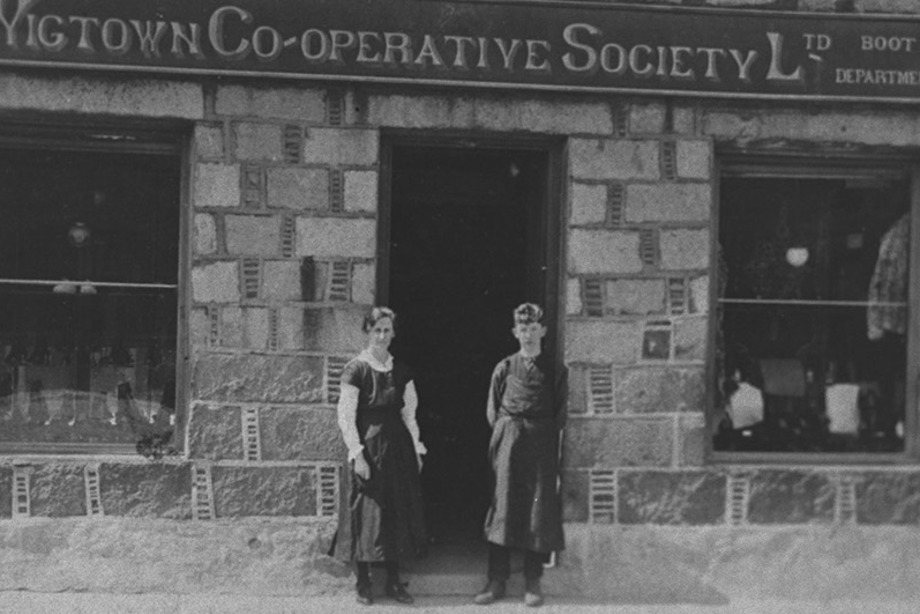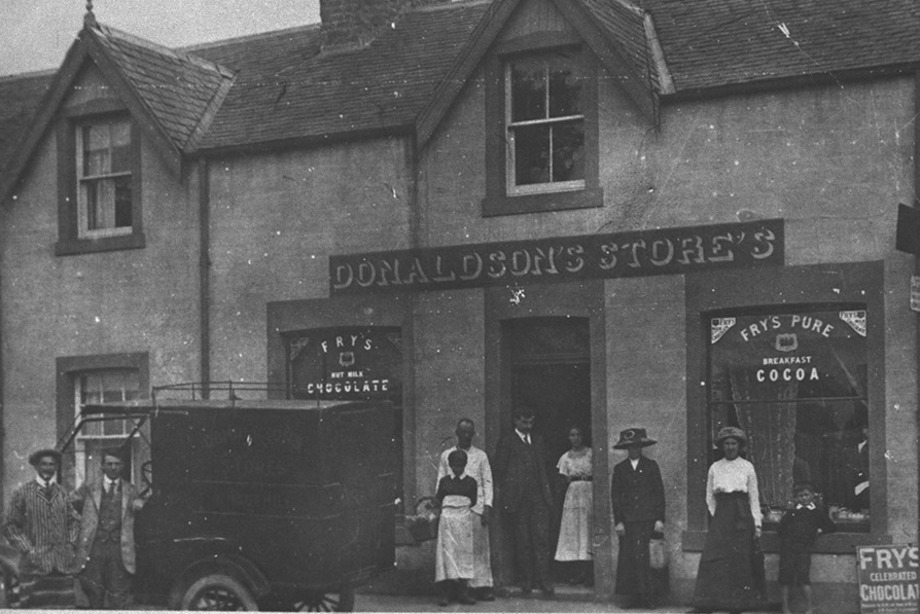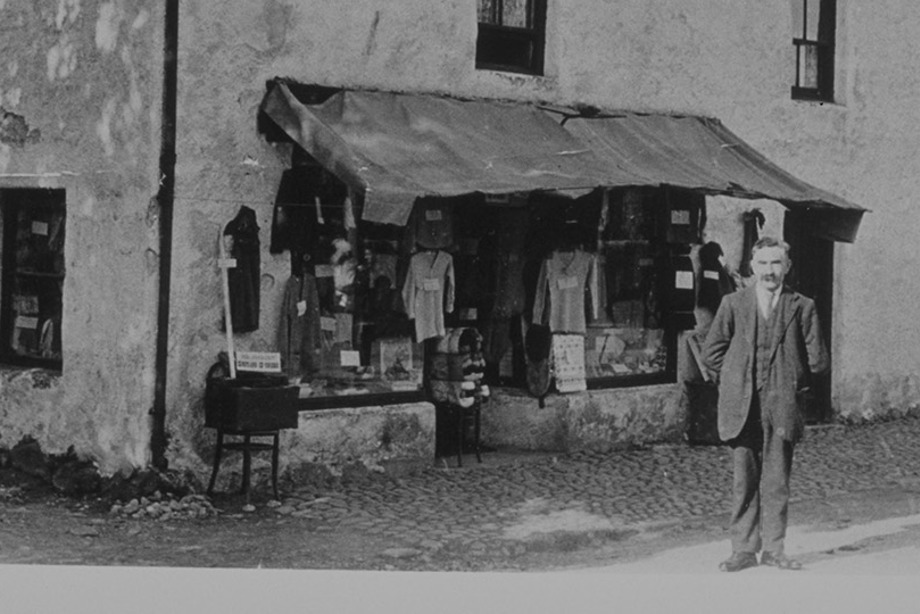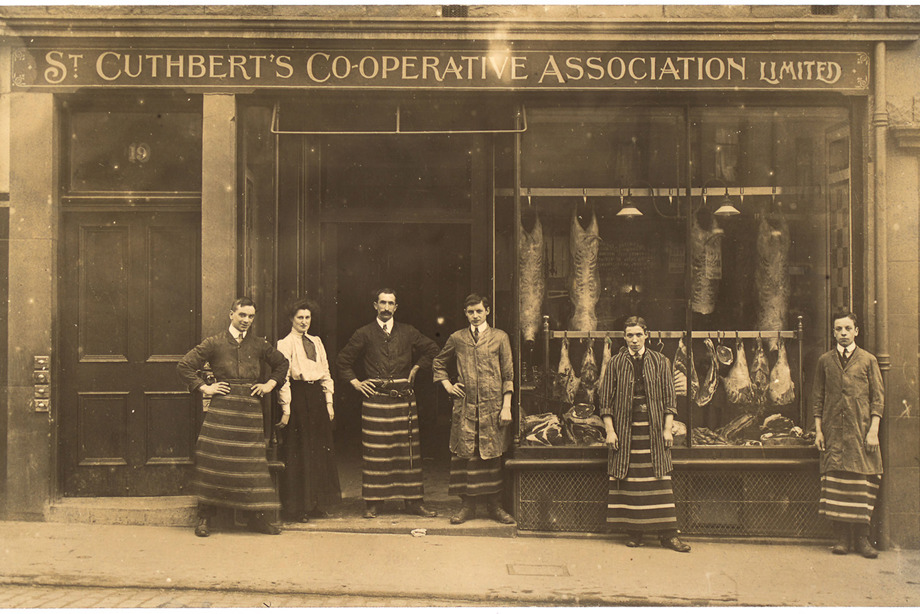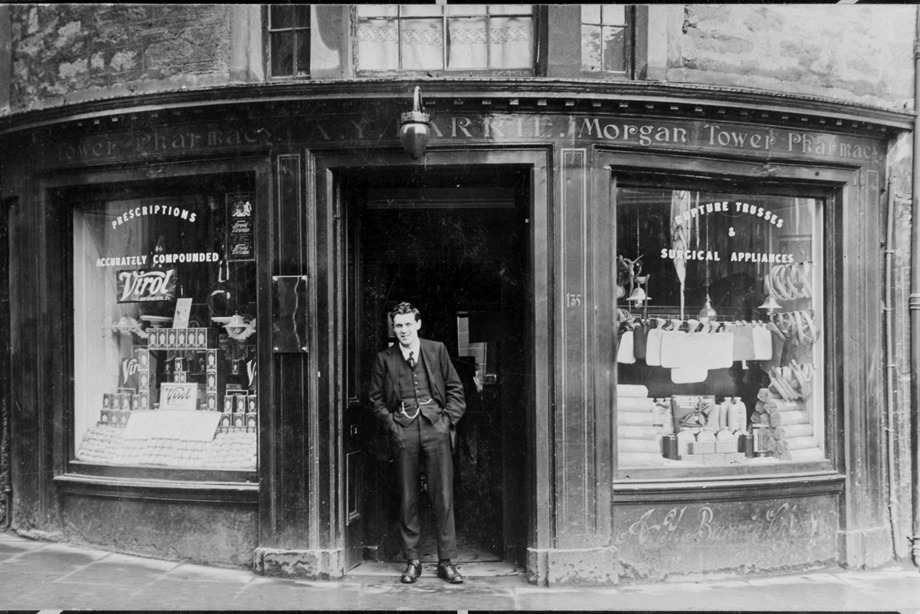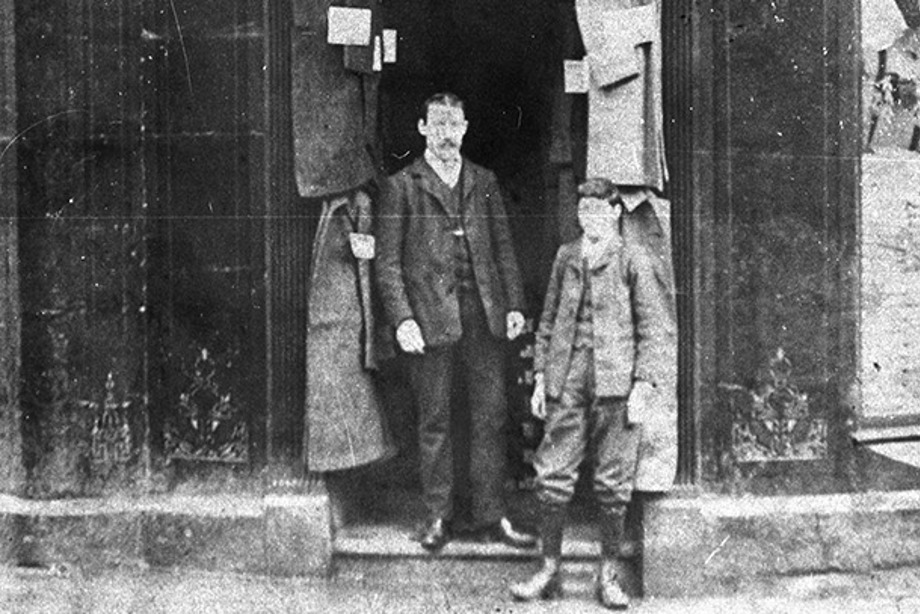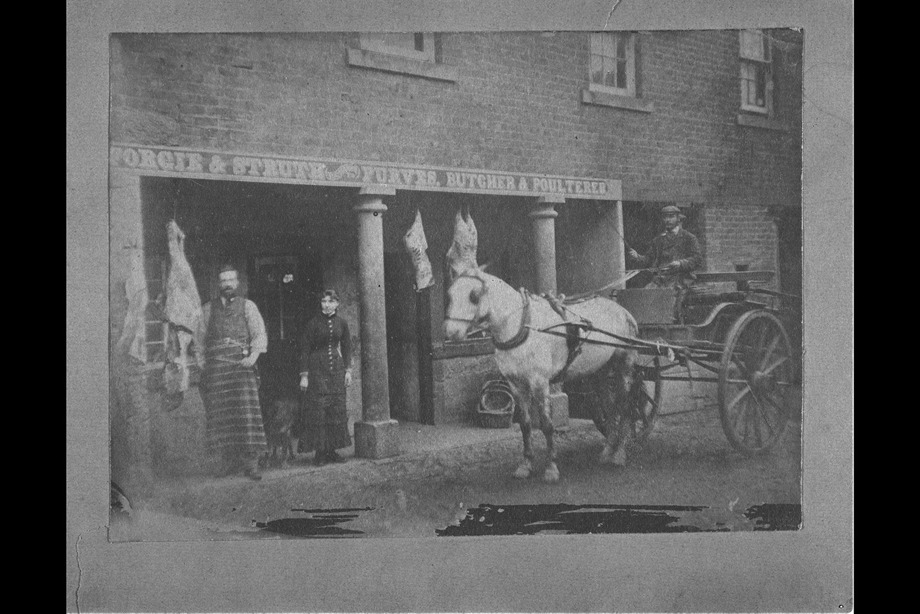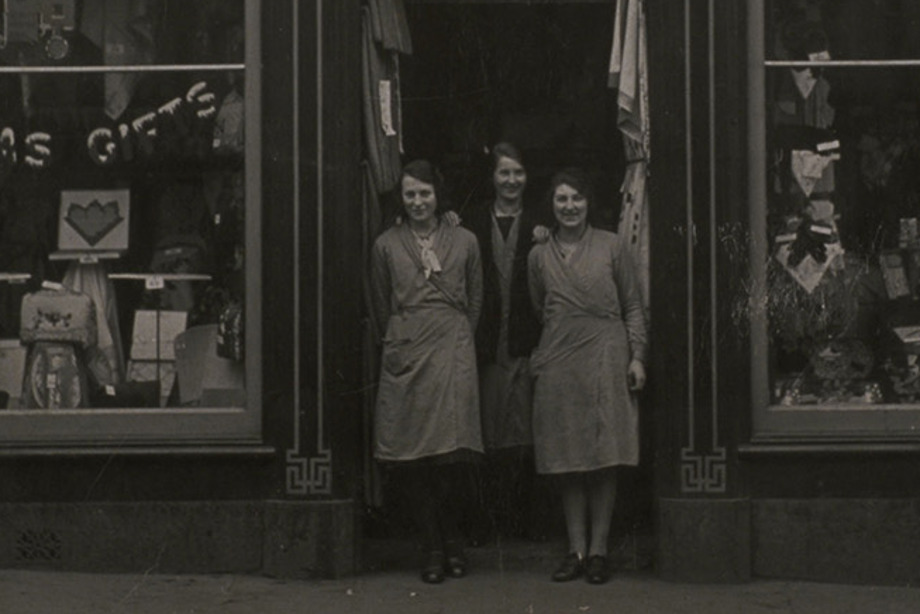From drapers and butchers to grocers to chemists, delve into the archives to meet some of the staff and owners of Scotland's historic shops.
Co-operative Society Shop in Wigtown, around 1920
Wigtown Co-operative Society was founded in 1899 when a creamery was opened at nearby Bladnoch. It took advantage of the transport facilities offered by the Wigtownshire Railway.
The Co-operative creamery at Bladnoch was a major employer, expanding to produce its own brand of Bluebell margarine, until closure in the late 1980's.
The shop was built of characteristic Creetown granite blocks, in North Main Street, Wigtown.
This archive photography collection of co-operative society shops and offices explores more.
McWilliam's Stores, Isle of Whithorn, around 1890
The picture features an unusually shaped wooden building, which houses the general stores for the port at the Isle of Whithorn.
Outside is a group consisting of customers, shopkeeper and delivery cart.
The McWilliams had been boat builders in the Isle of Whithorn. They used this building for their previous trade. John McWilliam remained harbourmaster at the Isle until his death in 1998.
The shop is situated at the point where, until the eighteenth century, high tides used to cut off the "Isle" from the mainland. The area is now built up by a man-made quay. The old Free Kirk bell tower appears above the roof at the far right.
Village General Stores, Whauphill, around 1915
This shop was run by the Donaldson family.
Here, the shopkeeper is dressed in a long white apron. Lady customers are wearing the characteristic long skirt and blouse of the time.
The delivery men stand with the van, which were common sights on the roads. They brought news, as well as goods, to remote farms.
The lower windows to the right of the shop were enlarged for shop display. In this photo, you can see early advertisements for Fry's Cocoa.
Drapers Shop, Main Street, Newtonmore
The building in this photograph, now Craigellachie House, was built around 1823 as an Inn when the new bridge was built over the River Spey.
The gentleman standing in front of the shop is Alexander MacDonald, nicknamed 'the Boomler' by the local community.
He travelled down from Inverness each week to work in the shop.
The photograph shows a fine display of garments for sale including knitwear, caps and knitting wool.
On the left hand side of the shop door there is a box on a chair with the sign 'Fine Hand Knit Shetland Spencers'. Spencers were short jackets worn by women.
The awning, to protect the clothes from sunlight, has been made out of some rough pieces of canvas.
See similar shops in this archive collection of Drapers stores.
St. Cuthbert's Co-operative Association Limited Butchers, Edinburgh, around 1900
The location is thought to be 17 Rodney Street in Edinburgh.
The staff of the butcher's shop, wearing the traditional butcher's uniform of striped aprons, are lined up in front of the shop for the photograph.
The meat is hanging on hooks in the front window behind them. In the days before proper refrigeration and knowledge of disease, the meat industry was much less hygienic than it is now.
From the nineteenth century onwards, more shops offered a wider range of goods to the consumer than ever before. The development of local butcher's shops made it increasingly easy for townsfolk to buy meat on their own doorsteps.
St Cuthbert's still had a butcher meat department there in the 1940s according to Edinburgh & Leith Post Office Directory.
These archive photos of butchers shops includes one which shows off their decorative tiling.
The Morgan Tower Pharmacy, Nethergate, Dundee, around 1921
A pharmacy has been housed in this building since around 1875.
The smartly dressed man in the doorway is William M. Dougal Stewart, the manager of the shop.
Chemists held a stock of raw materials on their shelves, which they would combine according to the doctor's prescription. The medicines would all be made within the premises of the shop.
The Morgan Tower, where this chemist is located, was erected about 1786 to the design of a local architect, Samuel Bell, and is reputed to be the oldest continually inhabited house in the city.
The original proprietor, when the premises were known as Morgan's buildings, has not been identified, but the name Morgan has always been associated with it.
These archive photos of pharmacy's show stained glass features and internal fittings.
J.Galloway's Gents Outfitters, Cupar, Fife, around 1905
Standing in the doorway of the shop is J.Galloway and in front of him is David Campbell.
Hanging from the doorway and on display in the shop windows are some of the garments that could be bought on the premises.
From the mid-nineteenth century, many street markets were closed down and rehoused in clean new buildings. More and more shops offered an ever increasing range of goods and services to the customer.
Struth's of North Berwick
North Berwick's Victorian butchers, Forgie, Struth and Purves, operated from a building on the north side of the High Street, which also housed the burgh slaughterhouse and a school.
The slaughterhouse was removed to a new site around 1900 and the butchers moved to other premises along the High Street around the same time.
This is a black and white photograph of a butchers premises. The shopfront is set back behind a colonnaded porch, above which is a narrow painted sign. A man and woman stand beside a portion of hanging meat; on the right there is a horse drawn gig.
The period between 1850 and around 1910 was a time of great prosperity for merchants and shopkeepers in North Berwick. The town had expanded both in terms of population and available housing because it was popular as a holiday resort and several large hotels, villas and apartments for lease were built.
Laidlaw's Drapery Shop in Tranent, around 1930
This picture was probably taken about 1930, when the proprietor of 49/51 High Street, Tranent was Adam Laidlaw, a Clothier.
The three ladies in this black and white photograph are pictured at the doorway of Laidlaw and Son's drapery shop in Tranent.
The business was established in 1888 and was 'Celebrated for superior Dyeing and Cleaning of Ladies' and Gent's Garments, Curtains and other Furnishings'.
Garments for cleaning were delivered to 49/51 High Street and collected after receiving attention at a cleaners in Perth.
The business continued into the 1970s when it became known as James Laidlaw & Son (Drapers) Limited.
Shop, West Barns
Until the middle of the 20th century even small villages such as West Barns (with a population of around 500) had an extensive range of shops and other businesses. Many offered more than a single service - this establishment diversified into motor hire.
This is a two storey house with three upper windows and a pantiled pitched roof. Above the central doorway an advertising board has been attached to the wall. Both ground floor windows have displays of produce.
In larger towns purpose built shop fronts and display windows became increasingly common in the early years of the 20th century. In rural centres an older style lingered on. This shop advertises with a board fixed to the front of an ordinary dwelling, the ground floor of which serves as a shop.
Scotland's Historic Shops continued
Continue your exploration of Scotland's extraordinary historic shops.

